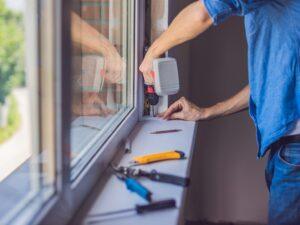As energy costs continue to rise, homeowners are increasingly looking for ways to improve their home’s energy efficiency. One of the most effective ways to achieve this is by optimizing your windows.
Energy-efficient windows can significantly reduce your utility bills, enhance indoor comfort, and lower your carbon footprint.
Here are ten practical tips to maximize window energy efficiency, ensuring your home stays comfortable year-round while keeping energy costs in check.
Key Takeaways
- Install energy efficient windows.
- Upgrade to double or triple-pane glass.
- Use Low-E glass coatings.
- Ensure proper window installation.
- Apply weatherstripping and caulking.
- Add insulating window treatments.
- Install reflective window films.
- Plant shading trees and shrubs.
- Regular window maintenance.
- Consider window upgrades.
Tip #1: Install Energy Efficient Windows
Investing in energy efficient windows is one of the best ways to improve your home’s energy efficiency.
Energy Star certified windows are designed to meet strict energy star criteria, offering superior insulation and reducing both heat loss and solar heat gain.
These windows have low U factors, which means they are effective in minimizing heat transfer, helping you save money on heating and cooling costs.
With these windows, you can significantly reduce energy bills, enhance indoor comfort, and lower your carbon footprint.
Tip #2: Upgrade to Double or Triple-Pane Glass
Double pane windows are designed to trap a layer of air or gas between the panes, which reduces heat transfer and improves insulation.
Triple-pane windows offer even greater efficiency, particularly in colder climates. Both types help to reduce energy costs by minimizing heat loss in the winter and heat gain in the summer.
The National Fenestration Rating Council rates these windows for their energy performance, making them an important consideration when looking to save energy and reduce your home’s carbon footprint.
Tip #3: Use Low-E Glass Coatings
Low-E (low-emissivity) glass coatings are essential for boosting energy efficiency. These coatings reflect solar radiation while allowing visible light to pass through, reducing the solar heat gain coefficient (SHGC) of your windows.
By lowering the SHGC, Low-E coatings help keep your home cooler during summer heat and warmer in winter, reducing cooling costs and overall energy use.
Tip #4: Ensure Proper Window Installation
Even the most efficient windows can underperform if they are not installed properly, leading to air leakage and higher energy costs.
It’s vital to have your new windows installed by professionals who understand the importance of a tight seal and correct alignment within the window frame.
Proper installation prevents energy loss and ensures that the windows’ U factor and SHGC ratings are fully realized.
This not only enhances your home’s energy performance but also helps reduce heating and cooling costs.
Tip #5: Apply Weatherstripping and Caulking
Weatherstripping and caulking help seal gaps around window frames, reducing air leakage and enhancing insulation.
This means less heated or cooled air escapes, leading to lower energy bills and better overall energy performance.
By properly sealing your windows, you can reduce heating and cooling costs, making your home more energy efficient.
Regular maintenance of weatherstripping and caulking is essential to keep your windows functioning at their best, ensuring continued energy savings and a comfortable living environment.
Tip #6: Add Insulating Window Treatments
Insulating window treatments such as curtains, blinds, and shades can significantly improve window energy efficiency.
These treatments help to block heat loss in winter and reduce solar heat gain during summer heat, leading to lower heating and cooling costs.
The Environmental Protection Agency recommends using these treatments in conjunction with energy efficient windows to enhance your home’s energy performance.
Tip #7: Install Reflective Window Films
Reflective window films are a cost-effective solution to improve window energy efficiency by reducing solar heat gain.
These films work by reflecting solar radiation, which lowers the SHGC of your windows. This is particularly beneficial in hot climates where cooling costs can be high.
By reducing the heat gain, reflective films help keep your home cooler, leading to significant energy savings.
Tip #8: Plant Shading Trees and Shrubs
Planting shade trees and shrubs around your home is an effective way to naturally improve window energy efficiency.
These plants provide shade, reducing solar heat gain and cooling energy costs during hot climates.
By strategically placing trees and shrubs near windows, you can block excess solar radiation while still allowing natural light to enter your home.
This not only helps to reduce your energy bills but also contributes to a lower carbon footprint.
Tip #9: Regular Window Maintenance
Checking and repairing seals, cleaning the glass, and ensuring proper window frame alignment can prevent air leakage and energy loss.
Proper maintenance ensures that your energy efficient windows continue to perform at their best, reducing heating and cooling costs.
Maintaining your windows also helps to preserve the low U factor and SHGC ratings, which are critical for energy star certification.
By keeping your windows in good condition, you can enjoy continued energy savings and a comfortable home environment.
Tip #10: Consider Window Upgrades
If your windows are old or inefficient, upgrading to new, energy efficient windows can make a significant difference in your home’s energy performance.
Energy star-certified windows are designed to reduce heat loss and solar heat gain, leading to lower energy bills and improved comfort.
Replacing single pane windows with double or triple pane windows can further enhance energy efficiency by providing better insulation and reducing air leakage.
The Environmental Protection Agency recommends considering window upgrades as an important step in reducing energy costs and saving energy.
Wrapping Up
Improving your window energy efficiency is a key step toward reducing energy bills and enhancing your home’s comfort.
By following these tips, you can make a big impact on your home’s energy performance and contribute to a more sustainable environment.










